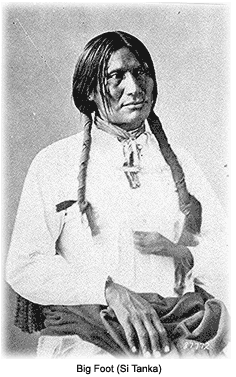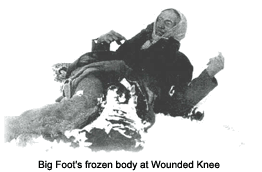Chief Big Foot was born between 1820 and 1825 into the Minneconjou — "Planters by the River" — subgroup of the Teton Lakota (Sioux). One of the seven subdivisions of the Teton Sioux, the Minneconjou lived in northwestern South Dakota with the Hunkpapa, another band of the Teton Lakota led by Chief Sitting Bull . Chief Big foot's Lakota name was Si Tanka, or Spotted Elk. He was the son of Lone Horn, and became the leader of his tribe at his father's death in 1874.
 1870–1890: the pre-Ghost Dance years
Chief Big Foot was a man of peace, and best known among his people for his political and diplomatic successes. He was skilled at settling quarrels between rival parties, and was often in great demand among other Teton bands.
During the 1870s, he allied himself with Sitting Bull and Chief Crazy Horse against the U.S. Army, but saw no major action during the war in 1876-77. The Miniconjou Lakota suffered during the Sioux War for the Black Hills (1876–77), after which they surrendered. Following the defeat of the Sioux, Big Foot urged his followers to adapt to the white men’s ways while retaining their Lakota traditions.
Following the Sioux Wars, the government placed the Minneconjou on the Cheyenne River Reservation in South Dakota. Big Foot encouraged his people to adapt to life on the reservation by developing sustainable agriculture and building schools for Lakota children. Big Foot was among the first American Indians to raise corn in accordance with government standards.
Big Foot served as a delegate to Washington, D.C., where he tried to win favor for Native Americans and lobbied for a school to be built on the reservation. Despite the fact that the Bureau of Indian Affairs hesitantly agreed, they never acted on it, and eventually it was forgotten. At the same time, he also advocated that his people take a peaceful attitude toward white settlers.
The Ghost Dance years
The living conditions on the reservations were so appalling that, by the late 1800s, many Lakota men, women, and children were on the precipice of starvation. As the government continued to appropriate tribal treaty land, crooked Indian agents often stole the money that the government had sent for food and supplies. The government also tried to terminate Native American culture by outlawing traditional religious practices.
By 1889, despair and wretchedness filled the tinderbox, and the Lakota were primed to explode into a great fire. Unbearable conditions made the Lakota fanatically sympathetic to the Ghost Dance message, and many of the Lakota turned to the Ghost Dance religion initiated by Wovoka , a Paiute prophet. Big Foot and his people were among the most enthusiastic believers in the Ghost Dance ceremony when it arrived among the Lakota in the spring of 1890.
Although reservation rules outlawed the practice of the religion, the movement swept like a wild fire through their camps, causing local Indian agents to react with alarm. Some agents successfully suppressed the dancers; others called for troops to restore order.
After Sitting Bull was killed on the Standing Rock reservation in 1890, his followers fled to seek refuge with his half-brother, Chief Big Foot. In December 1890, fearing arrest and government reprisals against his band, Big Foot headed south to the Pine Ridge Reservation at the invitation of Chief Red Cloud. Red Cloud hoped that his fellow chief could help make peace. Hoping to find safety there, having no intention of fighting, and flying a white flag, Big Foot contracted pneumonia on the journey to Pine Ridge.
1870–1890: the pre-Ghost Dance years
Chief Big Foot was a man of peace, and best known among his people for his political and diplomatic successes. He was skilled at settling quarrels between rival parties, and was often in great demand among other Teton bands.
During the 1870s, he allied himself with Sitting Bull and Chief Crazy Horse against the U.S. Army, but saw no major action during the war in 1876-77. The Miniconjou Lakota suffered during the Sioux War for the Black Hills (1876–77), after which they surrendered. Following the defeat of the Sioux, Big Foot urged his followers to adapt to the white men’s ways while retaining their Lakota traditions.
Following the Sioux Wars, the government placed the Minneconjou on the Cheyenne River Reservation in South Dakota. Big Foot encouraged his people to adapt to life on the reservation by developing sustainable agriculture and building schools for Lakota children. Big Foot was among the first American Indians to raise corn in accordance with government standards.
Big Foot served as a delegate to Washington, D.C., where he tried to win favor for Native Americans and lobbied for a school to be built on the reservation. Despite the fact that the Bureau of Indian Affairs hesitantly agreed, they never acted on it, and eventually it was forgotten. At the same time, he also advocated that his people take a peaceful attitude toward white settlers.
The Ghost Dance years
The living conditions on the reservations were so appalling that, by the late 1800s, many Lakota men, women, and children were on the precipice of starvation. As the government continued to appropriate tribal treaty land, crooked Indian agents often stole the money that the government had sent for food and supplies. The government also tried to terminate Native American culture by outlawing traditional religious practices.
By 1889, despair and wretchedness filled the tinderbox, and the Lakota were primed to explode into a great fire. Unbearable conditions made the Lakota fanatically sympathetic to the Ghost Dance message, and many of the Lakota turned to the Ghost Dance religion initiated by Wovoka , a Paiute prophet. Big Foot and his people were among the most enthusiastic believers in the Ghost Dance ceremony when it arrived among the Lakota in the spring of 1890.
Although reservation rules outlawed the practice of the religion, the movement swept like a wild fire through their camps, causing local Indian agents to react with alarm. Some agents successfully suppressed the dancers; others called for troops to restore order.
After Sitting Bull was killed on the Standing Rock reservation in 1890, his followers fled to seek refuge with his half-brother, Chief Big Foot. In December 1890, fearing arrest and government reprisals against his band, Big Foot headed south to the Pine Ridge Reservation at the invitation of Chief Red Cloud. Red Cloud hoped that his fellow chief could help make peace. Hoping to find safety there, having no intention of fighting, and flying a white flag, Big Foot contracted pneumonia on the journey to Pine Ridge.
 On December 28, the 7th Cavalry intercepted them. Ill with pneumonia, Big Foot surrendered peacefully. The cavalry took him and his band into custody and escorted them to a site near Wounded Knee Creek, where they were to set up camp. The campsite was already established with a store and several log houses.
The final solution
That night, Big Foot and his people camped while being surrounded on all sides by well-armed soldiers. Some time during the evening, Colonel James Forsyth arrived, and took command of the troops and Big Foot's camp. The following morning, while the Army was trying to disarm Big Foot's band, tempers were hot on both sides. Someone's rifle discharged and the Army opened fire with four rapid-fire Hotchkiss Mountain cannons,* rifles, and pistols, slaughtering 290 men, women, and children. Big Foot was among them. That criminal action would later be known as The Wounded Knee Massacre.
On December 28, the 7th Cavalry intercepted them. Ill with pneumonia, Big Foot surrendered peacefully. The cavalry took him and his band into custody and escorted them to a site near Wounded Knee Creek, where they were to set up camp. The campsite was already established with a store and several log houses.
The final solution
That night, Big Foot and his people camped while being surrounded on all sides by well-armed soldiers. Some time during the evening, Colonel James Forsyth arrived, and took command of the troops and Big Foot's camp. The following morning, while the Army was trying to disarm Big Foot's band, tempers were hot on both sides. Someone's rifle discharged and the Army opened fire with four rapid-fire Hotchkiss Mountain cannons,* rifles, and pistols, slaughtering 290 men, women, and children. Big Foot was among them. That criminal action would later be known as The Wounded Knee Massacre.